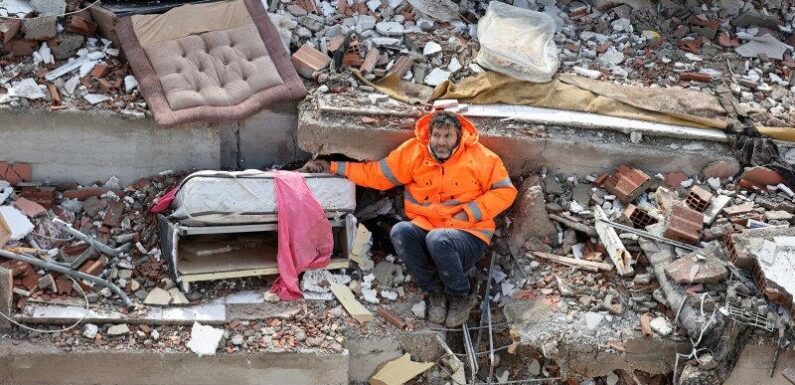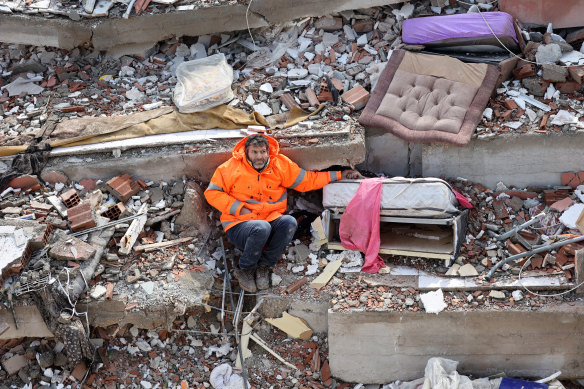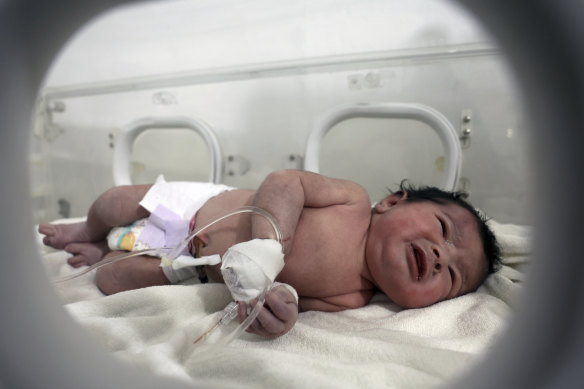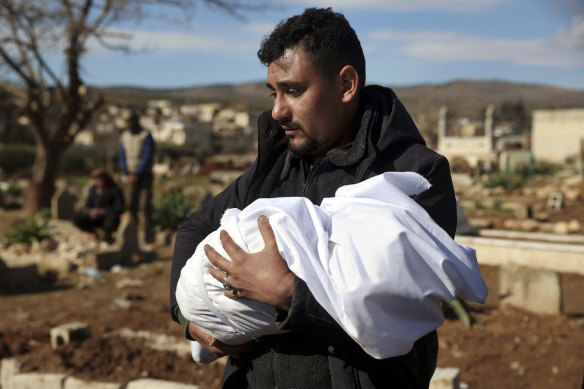
Warning: distressing content.
Jinderis: A heart-breaking image of a father holding the hand of his dead daughter trapped beneath a slab of concrete underscores the scale of the tragedy unfolding in Turkey and Syria in the aftermath of the deadly earthquakes.
The image, taken in Kahramanmaras, Turkey, comes as the rescue operation turns to a recovery operation in much of the affected areas.
Mesut Hancer holds the hand of his 15-year-old daughter Irmak, who died in the earthquake in Kahramanmaras, close to the quake’s epicentre. Credit:AFP
The picture shows Mesut Hancer, dressed in a high-vis coat, sitting on a pile of debris and holding the hand of his deceased 15-year-old daughter, Irmak, which sticks out from under a piece of concrete that fell onto her bed, crushing her to death.
Elsewhere, residents digging through a collapsed building in a northwest Syrian town discovered a crying infant whose mother appears to have given birth to her while buried underneath the rubble from this week’s devastating earthquake, relatives and a doctor said on Tuesday.
A baby girl who was born under the rubble caused by an earthquake that hit Syria and Turkey receives treatment inside an incubator at a children’s hospital in the town of Afrin, Aleppo province, Syria.Credit:AP
The newborn girl’s umbilical cord was still connected to her mother, Afraa Abu Hadiya, who was dead, they said. The baby was the only member of her family to survive from the building collapse Monday in the small town of Jinderis, next to the Turkish border, Ramadan Sleiman, a relative, told The Associated Press.
Monday’s pre-dawn 7.8 magnitude earthquake, followed by multiple aftershocks, caused widespread destruction across southern Turkey and northern Syria. Thousands have been killed, with the toll mounting as more bodies are discovered.
But dramatic rescues have also occurred.
Elsewhere in Jinderis, a young girl was found alive, buried in concrete under the wreckage of her home.
The newborn baby was rescued Monday afternoon, more than 10 hours after the quake struck.
After rescuers dug her out, a female neighbour cut the cord, and she and others rushed with the baby to a children’s hospital in the nearby town of Afrin, where she has been kept on an incubator, said the doctor treating the baby, Dr Hani Maarouf.
The baby’s body temperature had fallen to 35 degrees Celsius (95 degrees Fahrenheit) and she had bruises, including a large one on her back, but she is in stable condition, he said.
Abu Hadiya must have been conscious during the birth and must have died soon after, Maarouf said. He estimated the baby was born several hours before being found, given the amount her temperature had dropped.
If the girl had been born just before the quake, she wouldn’t have survived so many hours in the cold, he said.
A man carries the body of a family member who died in a devastating earthquake that rocked Syria and Turkey at a cemetery in the town of Jinderis, Aleppo province, Syria.Credit:AP
“Had the girl been left for an hour more, she would have died,” he said.
When the earthquake hit before dawn on Monday, Abu Hadiya, her husband and four children apparently tried to rush out of their apartment building, but the structure collapsed on them. Their bodies were found near the building’s entrance, said Sleiman, who arrived at the scene just after the newborn was discovered.
“She was found in front of her mother’s legs,” he said. “After the dust and rocks were removed the girl was found alive.”
Maarouf said the baby weighed 3.175 kilograms (7 pounds), an average weight for a newborn, and so was carried nearly to term. “Our only concern is the bruise on her back, and we have to see whether there is any problem with her spinal cord,” he said, saying she has been moving her legs and arms normally.
Jinderis, located in the rebel-held enclave of northwest Syria, was hard hit in the quake, with dozens of buildings that collapsed.
Abu Hadiya and her family were among the millions of Syrians who fled to the rebel-held territory from other parts of the country. They were originally from the village of Khsham in eastern Deir el-Zour province, but left in 2014 after the Islamic State group captured their village, said a relative who identified himself as Saleh al-Badran.
In 2018, the family moved to Jinderis after the Turkish-backed Syrian National Army, an umbrella for several insurgent groups, captured the town from US-backed Kurdish led fighters, Sleiman said.
On Tuesday, Abu Hadiya and the girl’s father Abdullah Turki Mleihan, along with their four other children were laid to rest in a cemetery on the outskirts of Jinderis.
Back inside the town, rescue operations were still ongoing in their building hoping to find survivors.
The town saw another dramatic rescue Monday evening, when a toddler was pulled alive from the wreckage of a collapsed building. Video from the White Helmets, the emergency service in the region, shows a rescuer digging through crushed concrete amid twisted metal until the little girl, named Nour, appeared. The girl, still half buried, looks up dazedly as they tell her, “Dad is here, don’t be scared. … Talk to your dad, talk.”
A rescuer cradled her head in his hands and tenderly wiped dust from around her eyes before she was pulled out.
The quake has wreaked new devastation in the opposition-held zone, centred on the Syrian province of Idlib, which was already been battered by years of war and strained by the influx of displaced people from the country’s civil war, which began in 2011.
Monday’s earthquake killed hundreds across the area, and the toll was continually mounting with hundreds believed still lost under the rubble. The quake completely or partially toppled more than 730 buildings and damaged thousands more in the territory, according to the White Helmets, as the area’s civil defence is known.
The White Helmets have years of experience in digging victims out from buildings crushed by bombardment from Russian warplanes or Syrian government forces. An earthquake is a new disaster for them.
“They are both catastrophes — a catastrophe that has been ongoing for 12 years and the criminal has not been held accountable, and this one is a natural catastrophe,” said the deputy head of the White Helmets, Munir Mustafa.
Asked if there was a difference between rescue work in the quake and during the war, he said, “We cannot compare death with death … What we are witnessing today is death on top of death.”
AP with The Age
Get a note directly from our foreign correspondents on what’s making headlines around the world. Sign up for the weekly What in the World newsletter here.
Most Viewed in World
From our partners
Source: Read Full Article


